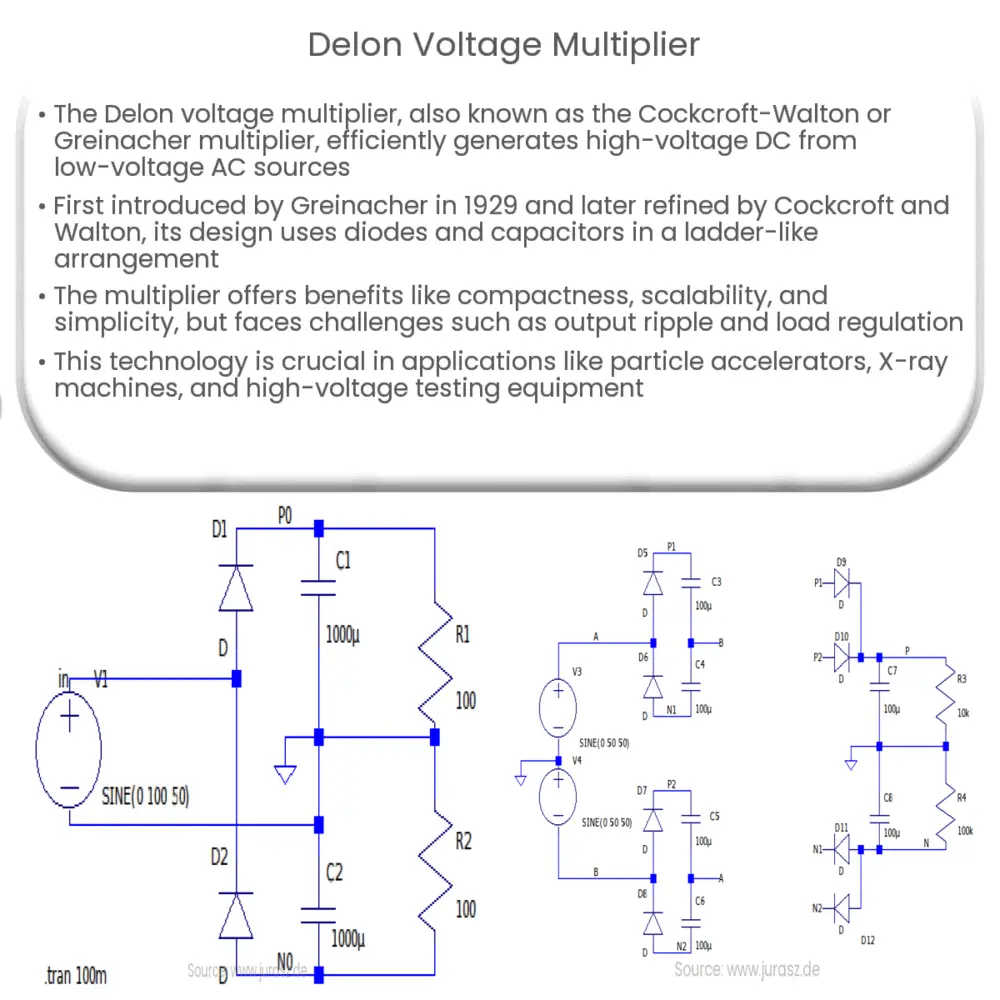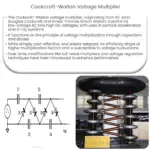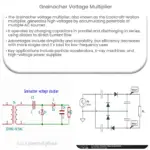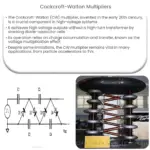The Delon voltage multiplier is a compact circuit that generates high-voltage DC from low-voltage AC sources, used in particle accelerators, X-ray machines, and testing equipment.

Delon Voltage Multiplier: An Overview
The Delon voltage multiplier, also known as the Cockcroft-Walton multiplier or Greinacher multiplier, is a circuit topology that efficiently generates high-voltage direct current (DC) from lower-voltage alternating current (AC) sources. This innovative design has seen widespread use in various applications, such as particle accelerators, high-voltage testing equipment, and X-ray machines.
Origins and Development
The Delon voltage multiplier was first introduced by Heinrich Greinacher in 1929. The concept was later refined by John Cockcroft and Ernest Walton in 1932 during their work on particle acceleration, leading to the alternative name “Cockcroft-Walton multiplier. The name “Delon voltage multiplier” is derived from Marcel Delon, who further developed the concept in the 1960s.
Operating Principle
The Delon voltage multiplier operates by taking advantage of the rectifying and charge-storing properties of diodes and capacitors, respectively. The circuit is constructed using a ladder-like arrangement of diodes and capacitors, with each stage of the ladder adding to the output voltage. This configuration allows the generation of high-voltage DC from a relatively low-voltage AC input.
During the positive half-cycle of the AC input, diodes in the circuit conduct and capacitors charge in parallel. In the negative half-cycle, diodes stop conducting, and the capacitors discharge in series, effectively adding their voltages together to create a higher voltage output. This process repeats for each half-cycle, with the output voltage increasing as the number of stages in the multiplier ladder increases.
Advantages and Disadvantages
The Delon voltage multiplier offers several advantages over other voltage-multiplying techniques. Some of the key benefits include:
- Compactness: The Delon multiplier’s ladder-like structure enables it to achieve high voltage multiplication in a relatively small footprint, making it ideal for applications with space constraints.
- Scalability: By simply adding more stages to the multiplier ladder, it is possible to achieve higher voltage outputs with ease, making it a flexible solution for various voltage requirements.
- Simplicity: The use of readily available components, such as diodes and capacitors, makes the Delon multiplier a cost-effective and straightforward solution for generating high-voltage DC.
However, the Delon voltage multiplier also has a few drawbacks, such as:
- Output Ripple: Due to the charging and discharging action of the capacitors, the output voltage may exhibit a ripple effect, which may require additional filtering for sensitive applications.
- Load Regulation: The output voltage may vary with changes in load current, necessitating the use of additional regulation circuitry in some cases.
Applications
The Delon voltage multiplier has found a variety of applications in many industries due to its ability to generate high-voltage DC from low-voltage AC sources. Some prominent applications include:
- Particle Accelerators: The high-voltage output of Delon multipliers has been instrumental in the development and operation of particle accelerators, which require large amounts of energy to accelerate charged particles to high speeds.
- X-ray Machines: Delon multipliers are used in X-ray machines to generate the high voltages required for producing X-rays, enabling medical professionals to visualize internal structures of the human body for diagnostic purposes.
- High-Voltage Testing Equipment: Delon multipliers are utilized in high-voltage testing equipment to verify the performance and safety of electrical devices and components under extreme voltage conditions.
- Electrostatic Precipitators: The high-voltage output from Delon multipliers is used in electrostatic precipitators for air pollution control, effectively removing particulate matter from industrial exhaust gases.
Improvements and Variants
Over the years, several improvements and variants of the Delon voltage multiplier have been developed to address its limitations and expand its range of applications. Some of these enhancements include:
- Switched Capacitor Multipliers: By incorporating active switching elements, such as transistors or MOSFETs, into the multiplier circuit, it is possible to achieve better load regulation and higher efficiency.
- Voltage Doublers and Quadruplers: Simplified versions of the Delon multiplier, such as voltage doublers and quadruplers, provide a more compact and efficient solution for applications that require only a moderate increase in voltage.
- Integrated Circuit (IC) Solutions: The development of high-voltage integrated circuits has enabled the miniaturization of Delon multipliers, facilitating their integration into compact electronic devices and systems.
Conclusion
The Delon voltage multiplier has proven to be a versatile and effective solution for generating high-voltage DC from low-voltage AC sources. Its compact and scalable design, along with its cost-effectiveness and simplicity, have made it an indispensable tool in various industries, including particle physics, medical imaging, and environmental protection. Despite some limitations, ongoing research and development efforts continue to improve the performance and broaden the range of applications for this remarkable circuit topology.




